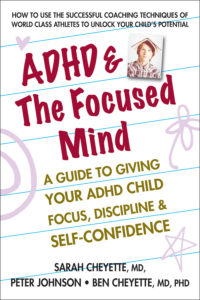Goal Setting for a Child with ADHD by Dr. Sarah Cheyette, MD (Book Excerpt)
*Adapted from ADHD & The Focused Mind © 2016 by Sarah Cheyette, MD, Peter Johnson, and Ben Cheyette, MD, PhD. Square One Publishers, Inc. Used by permission.
 STRATEGY #5: DITCH THE GOAL OR CHANGE THE PLAN
STRATEGY #5: DITCH THE GOAL OR CHANGE THE PLAN
Failing to achieve a goal that your child had previously set is also an opportunity for him to reevaluate whether or not it’s the right goal. It’s important to teach your child to use “flexible thinking.” Sometimes the goal—or the plan to achieve the goal—does need to be adjusted if it is not working out. Although we certainly don’t recommend “giving up”(or “choosing not to play”) as a general approach to challenges, it is important to balance persistence in the face of a setback with a thoughtful evaluation of what went wrong, and consideration of whether the goal is still the right goal and worth going for again. Taking a breather, or trying something else for a while, makes sense sometimes.
Sometimes the wrong goal was set to begin with. The initial goal may have been too ambitious—e.g., saying “I want to play basketball as well as Kobe Bryant” or “I will only be satisfied with 100 percent on the test” instead of “I want to improve my free throw percentage in basketball” or “I want to finish a test without making silly mistakes.” If the goal is too lofty, success will be elusive—and your child will not be able to celebrate. If perfection is the goal instead of progress, your child will remain unsatisfied because perfection is an unattainable ideal.
The economic concept of “sunk costs” can apply here. A sunk cost is a payment that cannot be recovered. Individuals sometimes continue pursuing what they have invested in (even if it is obvious that they will suffer further economic loss) because to change their path means to discard all the effort they’ve already placed into that strategy. As we’ve mentioned, the human brain is wired to avoid change and to avoid losing. Rationally, people should not make decisions about what to do in the future based on prior costs. Those costs are in the past, and can’t be changed; the decision about what to do next should be based on what could happen in the future. However, people often do make emotional decisions based on what they have already “sunk” into a project. The humorist Will Rogers wrote, “If you find yourself in a hole, stop digging.” Part of the reason why this is such a funny and enduring quip is because as obvious as it sounds, it is often difficult to do in practice. In short, it is very challenging to give up on a deeply held “core” belief, value, or task that you’ve already put effort into, but it may be the best thing to do to improve the future.
If your child keeps failing to reach his goal, is his heart fully in it? It may be worth examining his motivations for reaching the goal. Is he doing it for himself, or is he trying to fulfill another person’s wish for him? Remember that every child has to be committed to his or her own goal.
Sometimes people confuse the “plan” with the “goal.” In the quest to fulfill and stick to the plan, they may lose sight of the goal that led to the plan in the first place. It remains the case that the process (the plan) is important—and, in some sense, is more important than the goal itself. However, if the process was designed to achieve a goal that your child later decides is the wrong goal for him, then the process may need to change too.
This classic mistake is illustrated in the book-turned-movie The Bridge on the River Kwai. In it, the British Colonel Nicholson, a prisoner of war in a Japanese work camp, implements a plan to show up his Japanese captors and simultaneously demonstrate the spirit of his British men and the capability of his POW officer corps. He engages his men in building an amazing bridge for the Japanese, but in his zeal he forgets that his overall goal should not be to complete the building of a strong bridge, but to defeat the enemy by allowing that bridge to be blown to smithereens by British agents. In the end, he realizes that his goal was wrong and changes the plan, blowing up the bridge himself.
The goal is the outcome your child is committed to achieving; the plan is the tool he uses to achieve the desired outcome. Sometimes the goal is the right goal, but the plan isn’t the right plan. Both goals and plans should be reviewed regularly, especially if there is a setback—either the goal or the plan to achieve it can always be changed.
Take into consideration the concept of kaizen. Kaizen is the method, originally from Japan, applied in many businesses to make small, meaningful improvements in productivity. As the first step in kaizen, it’s important to have a clear plan that is easily visualized or written down, so that it has the potential to be reviewed and improved. That way, if your child finds that some aspect of his plan to achieve a goal isn’t working well for him, but he wants to keep his goal, he can tweak the plan. Using kaizen means that a plan can be improved incrementally until it is successful. The goal doesn’t need to be scrapped just because a plan doesn’t produce success right away without changes.
If your child is going to scrap the goal or the plan, it’s important to make sure he doesn’t decide to do this based on a negative mindset (e.g., when he is tired or discouraged). Tell your child to remember: What you do when you are working to keep your head above water is what defines you. Try to make sure your child is evaluating the goal or plan as a whole rather than basing his evaluations on his moment-to-moment feelings.
 Dr. Sarah Cheyette MD, graduated cum laude in Cognitive Neuroscience from Princeton University, and received her medical degree from the David Geffen School of Medicine at UCLA in Los Angeles. Following specialty training in Pediatrics at Cedars-Sinai Medical Center in Los Angeles and Pediatric Neurology at Seattle Children’s Hospital and Regional Medical Center, she settled with her family in the San Francisco Bay Area and established a private practice. She currently has a pediatric neurology practice at the Palo Alto Medical Foundation, where she focuses on the treatment of ADHD. For more information about Dr. Cheyette and her co-authors—husband Dr. Benjamin Cheyette, MD, PhD, and martial arts expert Peter Johnson—feel free to visit their website at www.adhdandthefocusedmind.com.
Dr. Sarah Cheyette MD, graduated cum laude in Cognitive Neuroscience from Princeton University, and received her medical degree from the David Geffen School of Medicine at UCLA in Los Angeles. Following specialty training in Pediatrics at Cedars-Sinai Medical Center in Los Angeles and Pediatric Neurology at Seattle Children’s Hospital and Regional Medical Center, she settled with her family in the San Francisco Bay Area and established a private practice. She currently has a pediatric neurology practice at the Palo Alto Medical Foundation, where she focuses on the treatment of ADHD. For more information about Dr. Cheyette and her co-authors—husband Dr. Benjamin Cheyette, MD, PhD, and martial arts expert Peter Johnson—feel free to visit their website at www.adhdandthefocusedmind.com.















